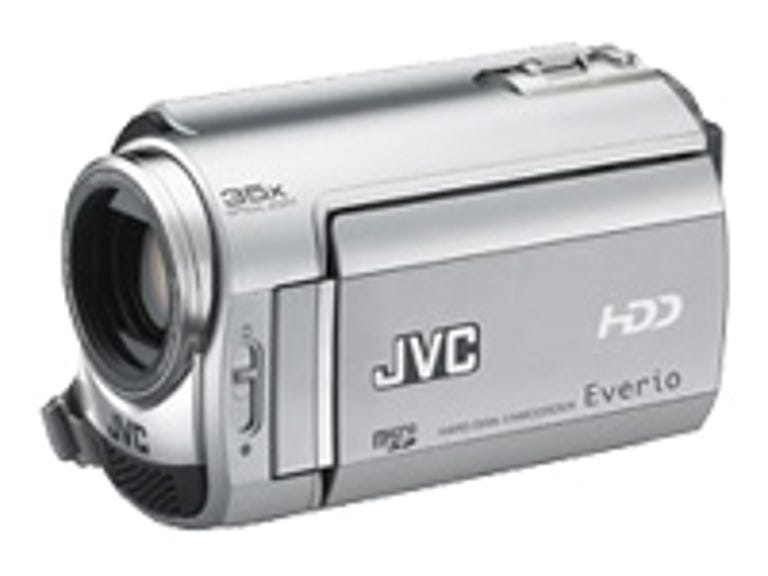 Why You Can Trust CNET
Why You Can Trust CNET JVC Everio GZ-MG300 review: JVC Everio GZ-MG300
JVC Everio GZ-MG300
With long recording times and convenient operation, hard-disk-based camcorders are quite tempting, especially when coupled with the relatively low prices for standard-definition models. That's true of the lowest-end camcorders in JVC's veteran Everio G series, which typically cost in the neighborhood of $350 to $450.
The Good
The Bad
The Bottom Line
The Everio GZ-MG3xx models come in a variety of flavors, though they're nearly identical in terms of features, performance, and image quality. The MG330 has a 30GB hard drive and comes in silver, blue, or red; the 60GB MG360 comes in black. Each of these two models has a sibling offering bundled with a Share Station dock, which is denoted by a model number ending in "5." The MG335 comes in silver or white, while the MG365, like the MG360, comes only in basic black. The dock provides S-Video and FireWire ports. For this review, we tested an MG330.
First and foremost, the whole of the MG300 series are very compact camcorders, measuring only 4.5 inches wide by 2.7 inches tall by 2.2 inches deep, and weighing about 12.7 ounces with battery. That's small enough to be of little consequence, even if you hold it for several hours. Unlike the touch screen, joystick, or jog dial controls used by other manufacturers, JVC has a unique Laser Touch control bar--a clever blue-light LED vertical touch-sensitive strip at the left of the 2.7-in LCD screen, which lets you quickly skim through all the menu selections. You make the actual selections with five small, recessed buttons at the bottom of the LCD. This arrangement is surprisingly functional. Frequently needed items sit at the top level of the menus, including video quality, gain control (for low-light shooting), aspect ratio (16:9 or 4:3), scene exposure modes, and backlight compensation. One level deeper into the manual settings menu reveals exposure compensation, manual focus, white balance, shutter speed, and metering options.
The camcorder offers a typical bundle of features for the money. It uses a 1/6-inch charge-coupled device sensor with 680,000-pixel resolution--pretty conventional for a standard definition camcorder--along with a 35x zoom lens and 2.7-inch wide-screen LCD monitor. Sadly, but unsurprisingly, no viewfinder is present.
It records MPEG-2 video in four quality modes with varying bit rates: Ultra Fine (8.5Mbps), Fine (5.5Mbps), Normal (4.2Mbps) and Economy (352x240 at 1.5Mbps). Though recording time increases as you decrease bit rate, quality also degrades, and Ultra Fine quality isn't so good that it can afford to decrease. With the 30GB hard drive, the camcorder's recording times range from about 7 hours in Ultra Fine mode to just over 37 hours in Economy; for the 60GB models, that doubles to 14 hours and 74 hours, respectively. You can also record video and stills to a Micro SD card. JVC includes a composite video/stereo RCA cable for TV playback, and bundles a CD of CyberLink software for transferring your video content from the camcorder to your Windows computer for further editing. You can also simply copy the files to your Mac or PC.
I most miss an eye-level viewfinder, though its absence is pretty common for models this size. LCDs can wash out in bright daylight or become difficult to see in low light; having a backup viewfinder is always a preferred option. Other omissions include a microphone jack, for connecting an external microphone to improve the quality of recorded audio in noisy environments, and a headphone jack, to hear what's playing back from the unit.
While the 35x zoom certainly provides a powerful range, I found it tricky to maintain a consistent, smooth zoom. The autofocus mechanism works quite well in good light, and will even focus quite well as close as 1 inch from an object. But, like much of its budget competition, it has a difficult time locking focus in low, low-contrast light. Digital image stabilization, the staple of budget camcorders, is also far less effective than optical stabilization, and generally isn't up to the needs of the high zooms on these models.
In general, color reproduction is very good, displaying both subtle tones and brightly colored subjects with relative accuracy. However, like many tapeless standard-def camcorders, there are quite a lot of compression artifacts in the video. They're especially noticeable when you compare moving subjects to relatively still backgrounds. Moving subjects normally record fairly well, at least at the highest quality settings, but backgrounds will appear somewhat blocky and low resolution (because MPEG-2 compresses areas that don't move a lot). Of course, these artifacts were far more noticeable on a 32-inch wide-format LCD at fairly close range and less so at a typical viewing distance of 8 to 10 feet. On a 42-inch or larger TV, though, the compression artifacts are always visible. (I shot in the Ultra Fine quality mode in 16:9 aspect ratio with normal gain in good light and increased gain in low light.) The VGA-resolution still photos are good for the Internet or for sharing via e-mail, but not much else.
That said, the JVC GZ-MG330, MG335, MG360 and MG365 are still practical, and useful camcorders for entry-level users who want to have a compact model for capturing everyday and event video without having to worry about running out of tape. They're also a bit cheaper than their counterparts from Sony (DCR-SR45 and SR65) and Panasonic (SDR-H40 and H60), but a real comparison will have to wait until CNET gets a chance to review any or all of those models.
